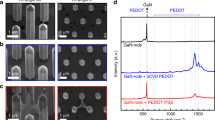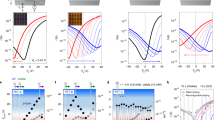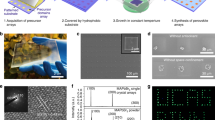Abstract
The development of complex electronics based on two-dimensional (2D) materials will require the integration of a large number of 2D devices into circuits. However, a practical method of assembling such devices into integrated circuits remains elusive. Here we show that a scanning visible light probe can be used to directly write electrical circuitry onto the 2D semiconductor molybdenum ditelluride (2H-MoTe2). Laser light illumination over metal patterns deposited onto 2D channels of 2H-MoTe2 can convert the channels from an n-type semiconductor to a p-type semiconductor, by creating adatom–vacancy clusters in the host lattice. With this process, diffusive doping profiles can be controlled at the submicrometre scale and doping concentrations can be tuned, allowing the channel sheet resistance to be varied over four orders of magnitudes. Our doping method can be used to assemble both n- and p-doped channels within the same atomic plane, which allows us to fabricate 2D device arrays of n–p–n (p–n–p) bipolar junction transistor amplifiers and radial p–n photovoltaic cells.
This is a preview of subscription content, access via your institution
Access options
Access Nature and 54 other Nature Portfolio journals
Get Nature+, our best-value online-access subscription
$29.99 / 30 days
cancel any time
Subscribe to this journal
Receive 12 digital issues and online access to articles
$119.00 per year
only $9.92 per issue
Buy this article
- Purchase on Springer Link
- Instant access to full article PDF
Prices may be subject to local taxes which are calculated during checkout





Similar content being viewed by others

Data availability
The data that support the findings of this study are available from the corresponding author upon reasonable request.
References
Britnell, L. et al. Strong light–matter interactions in heterostructures of atomically thin films. Science 340, 1311–1314 (2013).
Lee, C.-H. et al. Atomically thin p–n junctions with van der Waals heterointerfaces. Nat. Nanotech. 9, 676–681 (2014).
Kappera, R. et al. Phase-engineered low-resistance contacts for ultrathin MoS2 transistors. Nat. Mater. 13, 1128–1134 (2014).
Heo, H. et al. Interlayer orientation-dependent light absorption and emission in monolayer semiconductor stacks. Nat. Commun. 6, 7372 (2015).
Cha, S. et al. 1s intraexcitonic dynamics in monolayer MoS2 probed by ultrafast mid-infrared spectroscopy. Nat. Commun. 7, 10768 (2016).
Lee, M.-J. et al. Thermoelectric materials by utilizing two-dimensional materials with negative correlation between electrical and thermal conductivity. Nat. Commun. 7, 12011 (2016).
Geim, A. K. & Grigorieva, I. V. Van der Waals heterostructure. Nature 499, 419–425 (2013).
van der Zande, A. M. et al. Grains and grain boundaries in highly crystalline monolayer molybdenum disulphide. Nat. Mater. 12, 554–561 (2013).
Li, M.-Y. et al. Epitaxial growth of a monolayer WSe2–MoS2 lateral p–n junction with an atomically sharp interface. Science 349, 524–528 (2015).
Kang, K. et al. High-mobility three-atom-thick semiconducting films with wafer scale homogeneity. Nature 520, 656–660 (2015).
Zhao, M. et al. Large-scale chemical assembly of atomically thin transistors and circuits. Nat. Nanotech. 11, 954–959 (2016).
Liu, L. et al. Heteroepitaxial growth of two-dimensional hexagonal boron nitride template by graphene edge. Science 343, 163–167 (2014).
Gong, Y. et al. Vertical and in-plane heterostructures from WS2/MoS2 monolayer. Nat. Mater. 13, 1135–1142 (2014).
Heo, H. et al. Rotation-misfit-free heteroepitaxial stacking and stitching growth of hexagonal transition-metal dichalcogenide monolayers by nucleation kinetics controls. Adv. Mater. 27, 3803–3810 (2015).
Radisavljevic, B., Radenovic, A., Brivio, J., Giacometti, V. & Kis, A. Single-layer MoS2 transistors. Nat. Nanotech. 6, 147–150 (2011).
Britnell, L. et al. Field-effect tunneling transistor based on vertical graphene heterostructures. Science 335, 947–950 (2012).
Fang, H. et al. Degenerate n-doping of few-layer transition metal dichalcogenides by potassium. Nano. Lett. 13, 1991–1995 (2013).
Yang, L. et al. Chloride molecular doping technique on 2D materials: WS2 and MoS2. Nano. Lett. 14, 6275–6280 (2014).
Wang, S., Zhao, W., Giustinianoa, F. & Eda, G. Effect of oxygen and ozone on p-type doping of ultra-thin WSe2 and MoSe2 field effect transistors. Phys. Chem. Chem. Phys. 18, 4304–4309 (2016).
Tongay, S. et al. Broad-range modulation of light emission in two-dimensional semiconductors by molecular physisorption gating. Nano. Lett. 13, 2831–2836 (2013).
Qu, D. et al. Carrier-type modulation and mobility improvement of thin MoTe2. Adv. Mater. 29, 1606433 (2017).
Chang, Y. M., et al, Reversible and precisely controllable p/n-type doping of MoTe2 transistors through electrothermal doping. Adv. Mater. 30, 1706995 (2018).
Sung, J. H. et al. Atomic layer-by-layer thermoelectric conversion in topological insulator bismuth/antimony tellurides. Nano. Lett. 14, 4030–4035 (2014).
Sung, J. H. et al. Coplanar semiconductor–metal circuitry defined on few-layer MoTe2 via polymorphic heteroepitaxy. Nat. Nanotech. 12, 1064–1070 (2017).
Cho, S. et al. Phase patterning for ohmic homojunction contact in MoTe2. Science 349, 625–628 (2015).
Parzinger, E., Hetzl, M., Wurstbauer, U. & Holleitner, A. W. Contact morphology and revisited photocurrent dynamics in monolayer MoS2. npj 2D Mater. Appl. 1, 40 (2017).
Hla, S. W., Marinković, V., Prodan, A. & Muševič, I. STM/AFM investigations of β-MoTe2, α-MoTe2 and WTe2. Surface Sci. 352-354, 105–111 (1996).
Hong, J. et al. Exploring atomic defects in molybdenum disulphide monolayers. Nature Commun. 6, 6293 (2015).
Liu, X., Balla, I., Bergeron, H. & Hersam, M. C. Point defects and grain boundaries in rotationally commensurate MoS2 on epitaxial graphene. J. Phys. Chem. C 120, 20798–20805 (2016).
Zhang, S. et al. Defect structure of localized excitons in a WSe2 monolayer. Phys. Rev. Lett. 119, 046101 (2017).
Bin, C. et al. Environmental changes in MoTe2 excitonic dynamics by defects-activated molecular interaction. ACS Nano 9, 5326–5332 (2015).
Kleinman, D. A. & Schawlow, A. L. Corbino disk. J. Appl. Phys. 31, 2176 (1960).
Posposchill, A., Furchi, M. M. & Mueller, T. Solar-energy conversion and light emission in an atomic monolayer p–n diode. Nat. Nanotech. 9, 257–261 (2014).
Baugher, B. W. H., Churchill, H. O. H., Yang, Y. & Jarillo-Herrero, P. Optoelectronic devices based on electrically tunable p–n diodes in a monolayer dichalcogenide. Nat. Mater. 9, 262–267 (2014).
Lee, C. et al. Atomically thin p–n junction with van der Waals heterointerfaces. Nat. Nanotech. 10, 676–681 (2014).
Acknowledgements
This work was supported by the Institute for Basic Science (IBS), Korea under Project Code IBS-R014-G1-2018-A1. S.C. and H.C. were supported by the National Research Foundation of Korea (NRF) (NRF-2015R1A2A1A10052520 and NRF-2016R1A4A1012929). S.-Y.C. was supported by the Global Frontier Hybrid Interface Materials (GFHIM) of the NRF of Korea (2013M3A6B1078872). K.S. acknowledges the Fundamental Research Program of the Korean Institute of Materials Science.
Author information
Authors and Affiliations
Contributions
M.-H.J. and S.-Y.S. conceived and designed the project. S.-Y.S. fabricated the devices and performed light-induced doping experiments, as well as electrical characterizations. Jaehyun P. and Jewook P. performed the STM measurements and analysed the data. H.W.Y. provided the STM set-ups. K.S. and S.-Y.C. acquired the STEM images and analysed the data. S.C., S.S. and H.C. carried out the photocurrent measurements. M.-H.J., S.-Y.S. and Jewook P. co-wrote the paper. All authors discussed the results and commented on the manuscript.
Corresponding author
Ethics declarations
Competing interests
The authors declare no competing interests
Additional information
Publisher’s note: Springer Nature remains neutral with regard to jurisdictional claims in published maps and institutional affiliations.
Supplementary information
Supplementary Information
Supplementary Figures 1–16 and Supplementary Table 1
Rights and permissions
About this article
Cite this article
Seo, SY., Park, J., Park, J. et al. Writing monolithic integrated circuits on a two-dimensional semiconductor with a scanning light probe. Nat Electron 1, 512–517 (2018). https://doi.org/10.1038/s41928-018-0129-6
Received:
Accepted:
Published:
Issue Date:
DOI: https://doi.org/10.1038/s41928-018-0129-6
This article is cited by
-
Fabrication of p-type 2D single-crystalline transistor arrays with Fermi-level-tuned van der Waals semimetal electrodes
Nature Communications (2023)
-
Electronic Janus lattice and kagome-like bands in coloring-triangular MoTe2 monolayers
Nature Communications (2023)
-
Fabrication of patterned transparent conductive glass via laser metal transfer for efficient electrical heating and antibacteria
Nano Research (2023)
-
Two-dimensional materials-based integrated hardware
Science China Information Sciences (2023)
-
Two-dimensional devices and integration towards the silicon lines
Nature Materials (2022)


